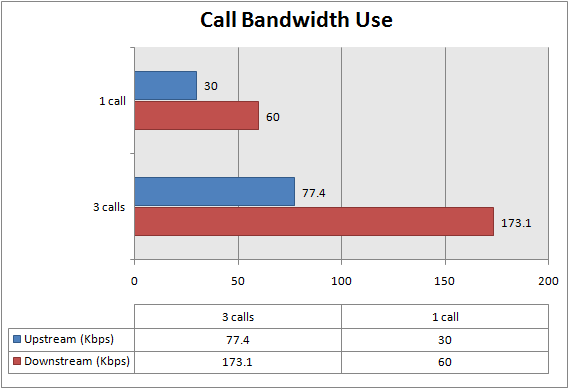AT&T 3G MicroCell: A Comprehensive Exploration
by Brian Klug on April 1, 2010 1:55 AM EST- Posted in
- Smartphones
- AT&T
- Microcell Review
- Mobile
Performance - Voice and SMS
Throughout the coverage radius, voice calls were basically as good as you'd expect them to be. Of course, right at the edge of the coverage radius there was noticable distortion and blocking like you'd normally expect. That said, calling works perfectly. I started with one device, and gradually added until I got to four devices.
Every device calling me - more calling in 2 minutes than I do in a month
There's really not too much to talk about quality wise, calling and SMS both work like they should when you're well within the range of the MicroCell. I did notice that call setup seemed to take longer occasionally, but don't have any explanation for it. There was also the occasional call that failed to setup, but again that was relatively rare. There wasn't any more perceptible audio lag than normal as well, something I've read callers definitely perceive occasionally.
I realized this was a perfect opportunity to get some real numbers about how much bandwidth a phone call actually uses. To do so, I set myself back up machine-in-the-middle style, setup a network bridge, and watched traffic. I initiated a conference call with three phones to each other in conference mode, and made some noise. This isn't as elegant as Anand's setup for call testing, but it gets the job done. I ran the test a few times with both one and two calls going, three just yielded the most smoothing. In practice, you'll see that bandwidth use is very uniform:

Three calls going
With a little math, we can really get a feel for how much bandwidth each call session is using:

This seems pretty reasonable, if a bit asymmetric. Then again, it's obvious that Cisco is being very careful about using limited upstream bandwidth, why not limit the return path just as much? Bear in mind that the same kind of downstream/upstream asymmetry applies across AT&T's 3G network, so these measures seem valid.
I also initiated call between two devices on the MicroCell and let it sit to see whether the call would drop after a long time - a number of people on the AT&T forums noted issues with longer calls. I successfully got up past a half hour, after which I terminated the call. I'm confident that it would have lasted should I have left it going.











63 Comments
View All Comments
leexgx - Friday, April 2, 2010 - link
the UMA thing looks good idea, seems Way more piratical then these base stations ( http://en.wikipedia.org/wiki/Generic_Access_Networ... ) only ever seen it on blackberry phones thought, only issue i could see with them is if it doe snot work with the wireless router correctly or intermittently out of range of routerjulioromano - Friday, April 2, 2010 - link
Very nice and geeky review.Thanks for all the infos!
Simozene - Friday, April 2, 2010 - link
1. These units need to be very cheap or free for consumers.2. Any minutes or data usage that is routed over this instead of AT&Ts regular network should not be counted towards the limits on your data plan. It's not their network so you should not have to pay for using it.
If those two conditions are met I can see how this could be a very useful product.
sxr7171 - Friday, April 2, 2010 - link
But it's not. It can't even hand off properly.Chrisg331 - Friday, April 2, 2010 - link
1st off, great article. Good methodology as well. Will you be able to test different handsets (Primarily different chipsets/antenna designs to eliminate bias on the dropped calls), possibly test a repeater (as mentioned before) and possibly test data usage pattern(s) for those that may be bandwidth capped on their broadband? Great job. Could really be useful to those looking to ditch landlines.GregHH - Friday, April 2, 2010 - link
In your haste to slam AT&T you neglect to notice that the other cell carriers offer the same type of device. That implies their coverage must not be perfect and all encompassing. Everyone seems to think cell coverage should be ubiquitous whether in a metro area or in the wilderness. I feel good that my area finally got 3G coverage in December of 2010.JKflipflop98 - Saturday, April 3, 2010 - link
So, we're in the future looking back on the past then? Or we're in the past looking towards the current? Oh God, my head's going to explode.ivwshane - Friday, April 2, 2010 - link
There is no required monthly cost. Buy just the microcell and use your existing minutes and data plan. Buy a microcell with a $20 feature and you can have unlimited minutes while using it and you also get a $100 rebate.No one is forcing anyone to buy these, at&t is simply giving it's users a choice, if you want to improve your in home coverage then buy one, otherwise don't.
mikeshady - Saturday, April 3, 2010 - link
So if I understand it correctly the price,$20/month unlimited calling$10/month with AT&T DSL
$0 with AT&T landline.
Will i be able to use it for the unlimited free since i have att landline
mrSHEiK124 - Tuesday, April 6, 2010 - link
Those failed handover videos; that happens ALL OF THE TIME on at&t in the Tampa, FL area. If you're on a highway or main-road and venture off into the boonies, as you get booted off 3G all you can hear is distortion (the handover is successful and the call doesn't drop, but good luck continuing the phone call...) and weird audio artifacts. at&t...more bars in more places.